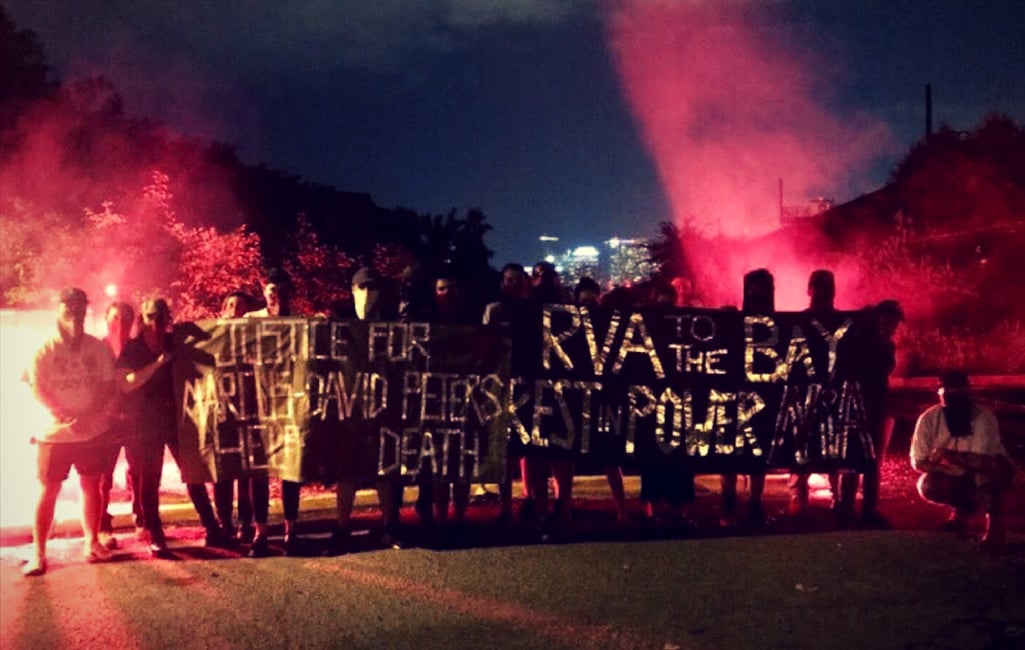I. The Vanishing Article
Back in 2018, the Virginia Mercury published a feature exploring Antifa Seven Hills, a Richmond-based collective that had become a flashpoint between police and self-styled “community-defense” activists.
Within hours of the Presidential Roundtable on Antifa, the story was quietly taken down—no correction, no editor’s note, only an empty URL and scattered screenshots rescued by the Wayback Machine and independent archivists on Reddit.
A Reddit thread reconstructed the sequence: local reporters began probing Antifa’s Richmond footprint; activist pressure escalated; the piece vanished.
Whatever the motive, the outcome was unmistakable—a local profile of Antifa’s Virginia chapter was wiped from public record.
The disappearance did what no manifesto could: it proved the network’s influence.
Not through open intimidation, but through a quieter mastery of reputational risk—the ability to make editors self-censor.
II. The Seven Hills Pattern
Before the deletion, Richmond already had a digital paper trail.
RVAMag, a counter-culture magazine once openly sympathetic to left-wing street activism, published detailed features on Antifa Seven Hills—the Richmond branch that coordinated protests and “community defense” actions around 2020.
The original coverage, now only accessible through archive snapshots and earlier versions, described an organization fluent in both logistics and ideology: first-aid training, encrypted messaging, and mutual-aid fundraising, all wrapped in an antifascist brand.
Mainstream outlets like VICE and Newsweek painted the same portrait in softer tones—Antifa members attending pro-gun rallies under the banner of “community defense,” denying alliances with extremists while sharing the same streets.
When RVAMag went dark on the subject, those archives became fossils—evidence of a brief moment when the press treated Antifa as a movement, not a myth.
III. The Torch Network: A Federation Without a Flag
The deletion trail leads upward—to the national hub TorchAntifa.org.
The site’s own History page recounts a 2013 schism from the Anti-Racist Action network, framing Torch as a federation of autonomous chapters sharing “anti-fascist, anti-racist, anti-capitalist” principles.
Its Chapters directory lists groups that operate like sovereign micro-states:
- Rose City Antifa (Portland, OR)
- Atlanta Antifa
- Central VA Antifa
- Front Range Antifa
- Antifascist Chicago
- Rocky Mountain Antifa
Every chapter maintains a separate web domain—blackblogs, noblogs, or Blogspot—and hosts mirror copies of statements, fundraisers, and doxxing guides.
It’s decentralization by design—a federation that survives by being impossible to decapitate.
Cross-referencing timestamps shows how this system functions: when one chapter releases a communiqué, half a dozen others repost within 24 hours, using identical phrasing and metadata tags. In practice, it’s a message bus—an ideological Tor network.
IV. Tactical Evolution: From Streets to Streams
Antifa’s public face in the 2010s was street protest.
Its 2020s evolution is digital: amplification, disruption, and reputational warfare.
Platforms like It’s Going Down act as distribution channels—posting event recaps, prisoner letters, and manifestos under the language of “autonomous media.”
Regional satellites like AvlAntiRacism in North Carolina or PNW Anti-White Conference (archived 2021) demonstrate the same template: localized branding, shared imagery, synchronized publication.
The infrastructure is European—servers in Germany, registrars in the Netherlands—selected precisely to stay beyond U.S. jurisdiction.
The result is a movement that behaves less like a protest network and more like an information-operations ecosystem.
In intelligence terms: Antifa has shifted from kinetic disruption (direct action) to cognitive disruption (narrative control).
V. The Web of Mirrors
The digital forensics are striking.
Every time local coverage exposes an Antifa cell, the pattern repeats:
- Publication releases critical story.
- Activists swarm the outlet with “safety” complaints and advertiser pressure.
- Article disappears.
- Archived copy propagates across Torch-affiliated domains within hours.
It’s a self-healing propaganda web. The erasure isn’t censorship—it’s proof of system resilience.
What disappears from Virginia Mercury re-emerges on noblogs.
What dies in Google search thrives on the Wayback Machine.
VI. The RICO Problem
Could this be prosecuted? Possibly, but not easily.
The Racketeer Influenced and Corrupt Organizations Act (RICO) was written for mob families, not encrypted collectives. It demands proof of an “enterprise” pursuing financial or material gain.
Antifa’s funding model—mutual-aid drives, PayPal chains, anonymous crypto wallets—muddies that test.
Yet investigators have noted repeating infrastructure: identical donation pages, recurring IP blocks, and pooled bail-fund accounts.
Those are functional equivalents of Mafia “consiglieri accounts.”
Legal scholars now float a hybrid theory: treat Antifa as a decentralized enterprise—the same logic DOJ used against online child-exploitation rings.
If the precedent extends, coordinated propaganda and shared fundraising could meet the RICO threshold, redefining “organized crime” for the digital era.
VII. Narrative Parallels: The Wu Mao Template
The propaganda resemblance is uncanny.
China’s 50 Cent Party floods domestic networks with comments reframing criticism as “foreign interference.”
Torch chapters perform the same function in reverse—framing domestic dissent as “fascism.”
Both rely on saturation, anonymity, and moral absolutism.
Both weaponize fatigue: overwhelm the audience until no one trusts any source.
Whether Antifa borrowed the playbook or simply evolved parallel tactics, the strategic DNA is identical—flood the zone, deny coordination, accuse your opponents of what you’re doing.
VIII. What the Archives Reveal
The combined Wayback evidence and the Torch sites sketch a real-time atlas of activity:
- Portland’s Rose City Antifa — recruiting for “mutual-aid patrols” around October 7 commemorations.
- Atlanta Antifa — issuing statements on the “Stop Cop City” trials, still framing defendants as “political prisoners.”
- Front Range Antifa — publishing doxxes of local police-union donors under “public transparency” posts.
- Central VA Antifa (CVAntifa) — cross-posting solidarity messages referencing Richmond Seven Hills heritage.
- Antifascist Chicago — fundraising for legal aid under identical banner graphics.
The pattern suggests more than ideology: it’s a franchise model without the paperwork.
IX. The Erasure Economy
When the Virginia Mercury story disappeared, the deletion was not unique—it was routine.
Every major outlet that once touched Antifa with curiosity has since defaulted to omission.
Editors describe it as “avoiding amplification.”
In practice, it’s abdication: refusing to document because documentation itself is risky.
Each absence strengthens the myth of Antifa’s invisibility, turning investigative journalism into a casualty of its own caution.
X. Conclusion: The Silence Between Headlines
The Antifa network today is not a street army; it’s a system of information control and narrative substitution.
Its resilience lies in its dispersion, its immunity in our reluctance to look.
When a local paper deletes an article, the movement doesn’t vanish—it metastasizes.
When a reporter hesitates, the void fills with propaganda.
The question isn’t whether Antifa exists.
It’s whether anyone is still allowed to say so.
Citations
- Reddit – “Virginia Mercury removes Antifa story after Presidential Round Table” (Oct 2025)
- Virginia Mercury – “VA Capitol Police Sergeant Placed on Leave Hours After Activists Post” (Oct 2025)
- VICE – “Why Antifa Is Siding With Thousands of Pro-Gun Conservatives in Virginia” (Jan 2020)
- Newsweek – “Antifa Deny Marching With Neo-Nazis at Virginia Gun Rally” (Jan 2020)
- RVAMag – “Inside Antifa Seven Hills” (archived) (Apr 2025 Archive)
- Torch Antifa – “History” (Accessed Oct 2025)
- Torch Antifa – “Chapters” (Accessed Oct 2025)
- It’s Going Down – Torch Network Posts (Accessed Oct 2025)
- AvlAntiRacism Blog (Accessed Oct 2025)
- Rose City Antifa (Accessed Oct 2025)
- Atlanta Antifa (Accessed Oct 2025)
- Central VA Antifa (Accessed Oct 2025)
- Front Range Antifa (Accessed Oct 2025)
- Antifascist Chicago (Accessed Oct 2025)
- Rocky Mountain Antifa Blogspot (Accessed Oct 2025)
- PNW Anti-White Conference (archived 2021)
- Wikipedia – “Racketeer Influenced and Corrupt Organizations Act” (Accessed Oct 2025)
- Wikipedia – “50 Cent Party” (Accessed Oct 2025)

